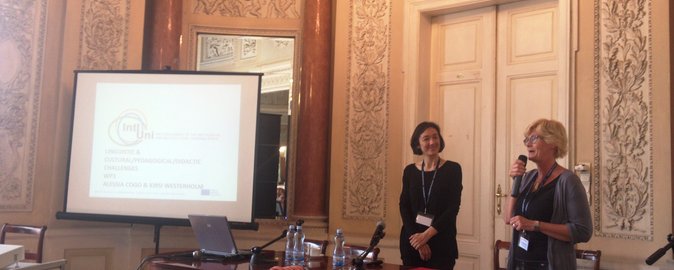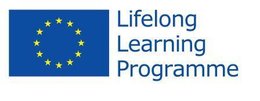IntlUni progress; Where are we now? And where are we headed?
Nine months into the project, the conclusions from the results of the 86-question survey completed by focus groups at 39 HEIs in 27 countries were extensively discussed at the 2nd Partner Meeting (5th- 7th June 2013) in Warsaw.
2013.08.01 |
In IntlUni’s pursuit – in this phase of the project – of what characterizes quality criteria for both teaching and learning in the Multilingual and Multicultural Learning Space (MMLS) at the multifarious participating HEIs, the focus of reflection was the draft synthesis report prepared by Karen M. Lauridsen (‘Introduction’), Sharon Millar and Margot van Mulken (WP2 ‘Identification of HEI Scenarios’) as well as Alessia Cogo and Kirsi Westerholm (WP3 ‘Identification of linguistic, cultural and pedagogical/didactic challenges’).
The task of the 2nd Partner meeting was to help prepare the ground for the final synthesis report, which will be published online in the next few months and open to comment from relevant stakeholders and experts.
Karen’s introduction was primarily directed at setting out what precisely constitutes internationalization within the European Higher Education Area, i.e. developing a working definition from the current literature on the topic that would provide a theoretical and contextual framework for the scenarios and challenges to be identified respectively by WP2 and WP3. It was clear that this was, in terms of the research available, an emergent field and would necessitate retrospective revision both with regard to ongoing developments at the global and regional levels as well as with a view to the interpretation and analysis of the quantitative research at an institutional level undertaken by WP2 and WP3.
As Karen pointed out, the specificity and dynamics of internationalization entails more than the volume of student/staff mobility. While this, alongside having say a more or less explicit language policy or indeed fully switching to English Medium Instruction (EMI), may be an adequate quantitative indicator of degrees of internationalization, in keeping with the project’s remit of classroom impact – “primarily what goes on in the [...] MMLS” – it does involve a more qualitative approach. Necessarily based on the “core activities of research and education”, i.e. curriculum development and pedagogical renewal, this would require consideration of the cultural and linguistic dimensions as these affect all students and lecturers, whether stay-at-home, potentially incoming or outgoing, and not just those who have been mobile.
This was taken up in the discussions that ensued and it was generally agreed that diversity – of cultures and academic traditions – rather than mobility per se needs greater emphasis. Further discussions also revealed that the MMLS in the full sense of the concept implies moving beyond the language(s) of instruction and must include the language(s) of learning, with due consideration given to both formal, non-formal and informal contexts, i.e. bottom-up as well as top-down responses to internationalization. In all the above, it was felt that this would lead to greater clarity and differentiation in analyzing and interpreting the results of the survey, as well as ensuring the added-value of the recommendations to be developed in the later WPs.
WPs 2 (Sharon and Margot) and 3 (Kirsi and Alessia) focused on presenting the results of the Europe-wide survey, with the former outlining current HEI scenarios and the latter their attendant linguistic, cultural and pedagogical/didactic challenges. Given the degree of diversity among the HEIs, both groups affirmed that it was not easy to draw hard and fast conclusions. Characteristics rather than a typology, as Karen had already pointed in her introduction, would enable a delineation of the scenarios. Yet, as came across in the discussions, even here one needs to be aware of any implicit assumptions underpinning interpretation of the data. Thus the five-stage rubric for discerning degrees of internationalization – extending from solely the L1 being used as the language of instruction through to apparently fully-fledged internationalization with either “multilingualism pur sang” (e.g. Finland) or EMI-only (e.g. adopted in many science faculties) – was critiqued for the progression it implied. Similarly, especially with a view to those concerned about the academic status of the major languages in Europe other than English, it was thought better to speak not of ‘the threat of English’ but rather of ‘domain loss’. At any rate, on a more mundane number-crunching level and leaving definitions of internationalization aside, it was clear from Sharon’s and Margot’s analysis that many HEIs across Europe often still lack the means to accurately estimate the number of incoming/outgoing students as well as to distinguish between vertical (those completing full degree programs outside the home country) and horizontal mobility (participants in exchange programs).
Moving beyond scenarios to the linguistic, cultural and pedagogical/didactic challenges faced by the HEIs, Kirsi and Alessia, while fully aware of the fact that it was “difficult, and most often even impossible, to separate language from culture”, began their resumé with the linguistic challenges. What they gleaned from the survey was that there was a mismatch between the respondents stating that generally students “have a sufficient level of proficiency in the language of instruction”, especially where internationally recognized language tests are “still used as a gatekeeping strategy by most HEIs”, and the fact that in the comment sections the latter tests were not generally viewed as giving an “accurate reflection of students’ linguistic competence to work in the academic environment”. Discussions here centred on the perceived North/South divide in Europe as a barrier to mobility as well as issues related to Standard/International English and the disciplinary divide between the so-called hard and soft sciences.
Kirsi and Alessia also noted that a considerable number of the comments “concerned the instructors’ and students’ perceptions of their own skills in the L2 and those of the other party”. Solutions offered and discussed by the Warsaw participants ranged from, for example, a more differentiated use of sub-scores in IELTS tests to the vexed issue of testing university staff, where a portfolio approach integrating didactic skills for L2s (Holland) was considered more appropriate than the generic TOEFL test for all (Belgium). Overall, it was felt that the internationalization of the curriculum and of the teaching and learning processes had not fully come to the fore in the survey. In order to gain a more comprehensive picture of this aspect – in Karen’s words to put ‘more flesh on the bone’, i.e. glean more substance on the educational and cultural challenges (WP3) facing participant HEIs – a follow- up qualitative study involving interviews at all the partner institutions needs to be completed before October 2013.
On the basis of these amended WP reports, the next phase (WP 4) will then seek to identify successful practice, which will ultimately lead us to define quality criteria for teaching and learning in the MMLS. The work on this stage will begin at our next Partner Meeting (6th- 8th of November), to be hosted by Essex University in Colchester (UK). Two other items of important news are that two new universities have joined us in the project – Universidad Complutense, Madrid (ES) and the University of Maastricht (NL) – and that Nemira Macianskiene (Vytautas Magnus University, LT) has been appointed to the Management Committee.


